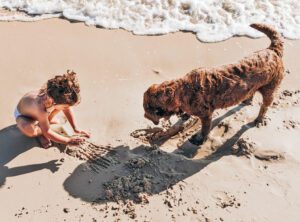After a fun day at the beach, you notice your dog is scratching and has small red spots that look like bites. It is possible, but unlikely, these are caused by sand fleas.
Sand fleas are small crustaceans, not insects like true fleas. They tend to come out on sandy beaches toward the evening, avoiding the hot sun. They vary in size from about a quarter of an inch to a full inch. However, unless you dig in the sand, you may not ever see them at a beach.
Insect Bites at the Beach
Skin irritations like itchy bites or welts are more likely caused by biting sand flies or actual fleas, especially if your dog has explored vegetation near the beach where rabbits and other animals that might harbor fleas have been.
Sand fleas do jump like true fleas, but they prefer to eat seaweed, not blood. When they do bite a dog, they can cause a rash that appears to be many bites.
Treatment for Bites
Treatment for irritation and bites from sand fleas is basic. Clean the area gently with water or a chlorhexidine solution. You can put an ice cube or ice pack on the red areas to reduce pain, itching, and inflammation.
Home remedies include aloe vera gel or a used tea bag held on the irritated skin. (Do not let your dog eat the tea!) Applying an apple cider vinegar and water solution (mix at 50-50) to wipe the area also may help with irritation and itching.
The biggest health concern with sand fleas is if your dog chews at his skin, destroying the natural protective barriers and leaving an opening for a secondary bacterial infection. Sand fleas also can cause tungiasis, a painful itchy condition where the flea bores into the dog’s paw pad (or human foot), but this is rarely seen in North America.
Keep your flea-and-tick repellent products up-to-date to help protect your dog.






